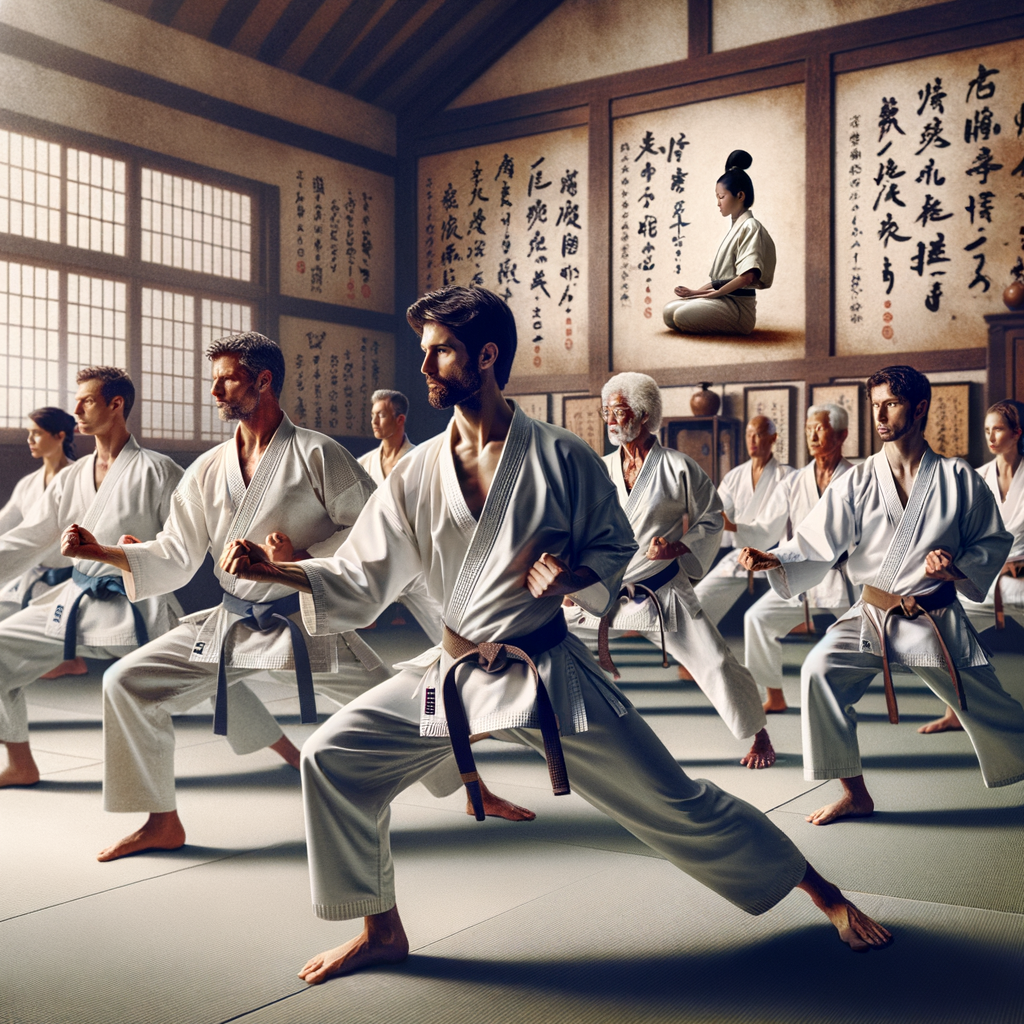
Introduction to Karate Traditions
-
The Significance of Karate
It teaches discipline, respect, and self-control. Practicing karate helps build physical strength and mental focus. Many people find that karate improves their confidence and helps them stay calm under pressure.
Karate also has a rich cultural heritage. It connects practitioners to a long history of martial arts and traditions. This connection to the past gives karate a unique and special significance.
-
Exploring the History of Karate
Originated in Okinawa, Japan. It was influenced by Chinese martial arts and developed over hundreds of years. The word “karate” means “empty hand” in Japanese, reflecting its focus on unarmed combat.
In the early 20th century, karate was introduced to mainland Japan. From there, it spread worldwide. Today, millions of people practice karate in dojos around the globe.
Karate’s history is full of fascinating stories and important figures. For example, Gichin Funakoshi is often called the “father of modern karate.” He played a key role in popularizing karate in Japan and beyond.
The History of Karate
Origins of Karate
- Early beginnings of karate:
Started a long time ago in Okinawa, Japan. People needed a way to defend themselves without weapons. They used their hands and feet to create a new form of fighting. This was the early beginning of karate. - Development of traditional karate practices:
Over time, karate became more organized. Masters taught students special moves and techniques. They practiced hard to get better. This helped karate grow into a traditional martial art.
Evolution of Karate
-
Changes in Karate Over the Centuries
Karate has changed a lot over the years. It started in Okinawa, Japan, and was influenced by Chinese martial arts. In the beginning, it was mainly about self-defense. People used it to protect themselves from attackers.
As time went on, karate spread to other parts of Japan. It became more structured and formal. Different styles of karate were developed. Each style had its own techniques and moves.
In the 20th century, karate became popular worldwide. It was introduced to the United States and other countries. Karate schools, called dojos, started to appear everywhere. People of all ages began to learn karate.
Today, karate is not just about fighting. It is also about fitness, discipline, and respect. Many people practice karate to stay healthy and to learn self-control.
-
Modern Karate vs Traditional Karate
Traditional karate focuses on the original techniques and philosophies. It is more about self-defense and personal growth.
Modern karate, on the other hand, includes new techniques and training methods. It often emphasizes competition and sport. People compete in karate tournaments to show their skills.
In traditional karate, students learn katas, which are set patterns of movements. These help them practice their techniques. Modern karate also includes katas, but there is more focus on sparring, where students practice fighting with each other.
Both modern and traditional karate have their benefits. Traditional karate helps people understand the history and culture of the martial art. Modern karate can be more exciting and competitive.
Aspect Traditional Karate Modern Karate Focus Self-defense, personal growth Competition, sport Techniques Original techniques New techniques Training Katas, discipline Sparring, competition Whether you choose traditional or modern karate, both can teach you valuable skills. Karate helps build strength, confidence, and discipline. It is a martial art that has evolved over the centuries but still holds its core values.
Karate Cultural Heritage
Significance of Karate in Japanese Culture
- Role of karate in cultural identity: More than just a martial art in Japan; it is a significant part of the cultural identity. Many Japanese people practice karate from a young age, learning discipline, respect, and self-control. It teaches values that are deeply rooted in Japanese culture.
- Impact of karate on Japanese society: It is practiced in schools, community centers, and dojos across the country. This widespread practice promotes physical fitness and mental well-being. Additionally, karate events and competitions bring communities together, fostering a sense of unity and pride.
Karate and Cultural Exchange
- Spread of karate worldwide: Today, people in many countries practice karate. For example, the United States, Brazil, and France have large karate communities. This spread has helped people learn about Japanese culture and traditions.
- Karate as a tool for cultural exchange: When people from different countries practice karate, they learn about respect, discipline, and the history of Japan. This helps build friendships and understanding between different cultures.
| Country | Number of Practitioners |
|---|---|
| United States | 500,000 |
| Brazil | 300,000 |
| France | 200,000 |
Karate has become a global phenomenon. It is not just about fighting; it is about learning and sharing. Through karate, people from different backgrounds come together, making the world a smaller and friendlier place.
Traditional Karate Practices
Karate Training Methods
-
Overview of Traditional Training Methods
- Kihon: Basic techniques such as punches, kicks, and blocks.
- Kata: Pre-arranged forms that simulate combat against multiple opponents.
- Kumite: Sparring practice to apply techniques in a controlled environment.
Each method focuses on different aspects of karate, helping students to develop a well-rounded skill set.
-
Significance of Discipline in Karate
- Respect: Bowing to instructors and fellow students shows respect and humility.
- Focus: Concentrating on each movement helps improve mental clarity.
- Perseverance: Consistent practice builds resilience and determination.
Discipline in karate not only improves physical skills but also fosters personal growth and character development.
Karate Rituals
-
Karate Rituals
Special actions and traditions followed by students and teachers. These rituals include bowing, meditation, and specific ways to start and end classes. Bowing shows respect to the teacher and fellow students. Meditation helps to clear the mind and focus on training.
For example, before starting a class, students line up and bow to the teacher. This is called “rei.” It is a way to show respect and readiness to learn. Another common ritual is “mokuso,” which is a short period of meditation to calm the mind.
-
Importance of Rituals in Karate Practice
They help create a sense of discipline and respect. When students follow these rituals, they learn to be more focused and serious about their training.
Rituals also help build a strong community. Everyone follows the same rules and traditions, which brings them closer together. This sense of unity is important for learning and growing in karate.
According to Wikipedia, rituals in martial arts like karate help maintain the cultural heritage and teach important values like respect, discipline, and focus.
Karate Philosophy
Principles of Karate
- Exploring the philosophical aspects of karate:It teaches us important life lessons. The word “karate” means “empty hand,” which shows that it is about self-defense without weapons. But it also means having a clear mind and a humble heart.
One key principle is Dojo Kun, which are the rules of the dojo (training hall). These rules include seeking perfection of character, being faithful, endeavoring, respecting others, and refraining from violent behavior.
- How karate principles apply to daily life:For example, the principle of respect teaches us to be kind to others. Discipline helps us stay focused on our goals. Perseverance encourages us to keep trying, even when things are tough.
Many people find that practicing karate helps them become more confident and calm. It can also teach us to be patient and to think before we act.
Discipline and Respect in Karate
-
Importance of Discipline in Karate
It helps students stay focused and improve their skills. In karate, students follow strict rules and routines. This helps them learn self-control and patience. For example, they practice the same moves many times to get better. This shows how discipline helps them grow.
Discipline also helps in other parts of life. It teaches students to set goals and work hard to achieve them. This is useful in school, sports, and even at home. A disciplined karate student is often more successful in many areas of life.
-
Role of Respect in Karate Philosophy
Students must show respect to their teachers, classmates, and even their opponents. This is a big part of karate philosophy. It teaches students to value others and treat them well.
In a karate class, students bow to their teacher and each other. This shows respect and gratitude. Respect in karate also means listening carefully and following instructions. This helps create a positive and supportive learning environment.
Respect in karate goes beyond the dojo (training place). It teaches students to be kind and considerate in everyday life. This makes them better friends, family members, and citizens.
Conclusion: The Lasting Significance of Karate Traditions
Karate traditions have stood the test of time. They offer more than just physical skills. They teach values, discipline, and respect. Let’s explore why these traditions continue to be important and what the future holds for them.
-
- Why karate traditions continue to be important
They remind us of the history and culture of karate. These traditions also teach us valuable life skills. For example, the practice of bowing shows respect. The discipline needed to master karate helps in other areas of life too.
Many people find that karate helps them stay fit and healthy. It is a great way to exercise and build strength. Karate also helps with mental health. It can reduce stress and improve focus. These benefits make karate traditions valuable today.
-
- Future of karate traditions
More people are learning about karate every day. Karate schools are opening in many countries. This helps spread the traditions to new places.
Technology is also helping karate traditions grow. Online classes make it easier for people to learn karate. Videos and apps can teach the basics to beginners. This means more people can enjoy the benefits of karate.
However, it is important to keep the traditions alive. This means practicing the old ways and respecting the history of karate. By doing this, we can ensure that karate traditions will continue for many years to come.
| Aspect | Importance |
|---|---|
| Physical Fitness | Builds strength and keeps the body healthy |
| Mental Health | Reduces stress and improves focus |
| Respect and Discipline | Teaches valuable life skills |
| Global Reach | Spreads traditions to new places |
Karate traditions are more than just old practices. They are a way of life that offers many benefits. By keeping these traditions alive, we can enjoy a healthier and more disciplined life. The future of karate traditions is promising, and they will continue to be important for generations to come.





